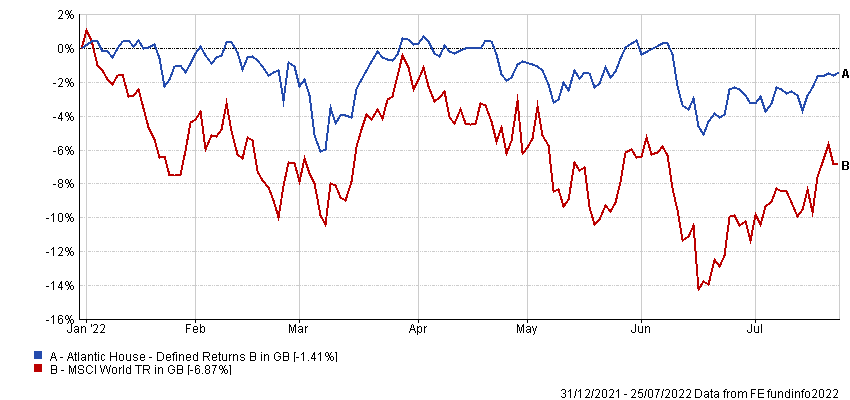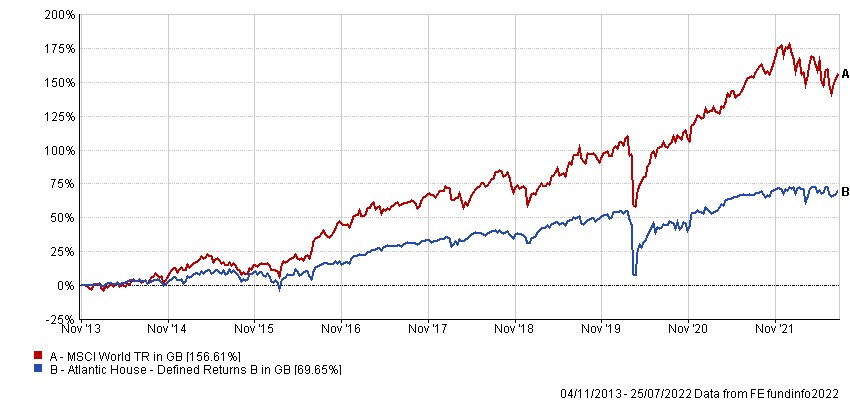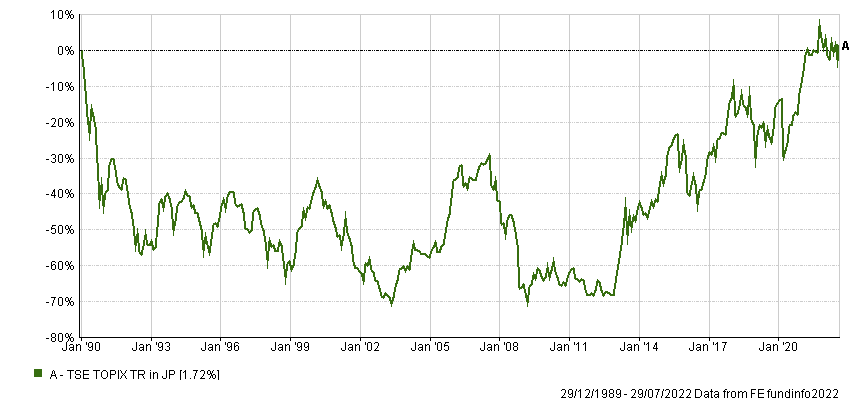The past year has acted as a reality check for investors who bought fully into the growth at-any-price mindset and served as a lesson that when something looks awfully like a bubble, it may be time to take some profits.
One manager who has managed to completely sidestep the volatility is Tom May, who runs Atlantic House Defined Returns. However, he would be the first to admit this has nothing to do with any skill in navigating the current market conditions, and is instead entirely down to the structure of his fund.
Atlantic House Defined Returns aims to deliver a yield of 7 to 8% a year through holding a basket of autocalls, which are bonds with an equity overlay.
These structured products pay a high coupon if the underlying instrument – such as an equity index – passes a pre-determined level, at which point it automatically matures and the principal is returned.
The instruments May uses typically pay out in full so long as any fall is limited to 35% of the original value over a medium-term period. These give up any gains in the underlying indices, meaning the fund will underperform if the market is up by more than 8% a year. A more detailed example of these products can be seen at the bottom of the page.
This strategy has allowed May to limit falls this year to 1.4%, compared with 7.8% from the MSCI World index. He has delivered annualised returns of 6.2% since launch in 2013, but said the pullback in markets should make the 7 to 8% target easier to achieve in the future.
Performance of fund vs index in 2022

Source: FE Analytics
“The derivatives in our fund price better from an investor's point of view if interest rates and expectations of volatility are higher, and both of those things have happened this year,” he explained.
“We've been in a situation where some existing investments linked to major markets in the UK, Europe and the US have been rolling off. They've made their 7 to 8% per annum return over the three or four years we've held them, and we're now replacing them with similar instruments with better terms than we were getting before.
“If people think the investments they are buying now are going to be a bit stodgy, there's even more reason to hold the fund than there was three years ago.”
Yet while May admitted lower starting prices make the instruments in Atlantic House Defined Returns more attractive, this doesn’t mean he would make wholesale changes to the asset allocation if certain markets entered bubble territory.
Performance of fund vs index since launch

Source: FE Analytics
While this fund was only launched in 2013, May has been working with autocalls since 2000. He said that the last crash that would have caused investors in his fund to lose money over the medium term was the bursting of the Japanese asset bubble of the 1980s. UK investors who bought into the Topix at its peak at the start of 1990 had to wait 26 years to get their money back. Japanese investors, who bought in yen, only broke even last year.
Performance of index since 1990

Source: FE Analytics
Yet May said that even if another major index he is exposed to began to show signs of a bubble on the scale seen in the Japanese market of the late 1980s, he wouldn’t ditch it.
“Why is it a bubble?” he asked. “It’s very easy with hindsight to go back and say, ‘that was clearly a bubble’.
“There are plenty of people out there who will tell you why something’s a bubble and why it isn't and they will try to add alpha by getting out of the market they think is overpriced.
“But guess what? You can do a hell of a lot of really good work and get it completely wrong.”
While May wouldn’t ditch an index completely, he will tweak his portfolio around the edges. For example, at the end of last year when the US market was looking toppy, he avoided new trades that relied on the S&P 500 finishing above its starting value.
Instead, he favoured the UK and European markets, as they were trading on valuations about half those in the US.
“But that wasn't us saying ‘let's get out of US’,” he explained. “We're not in the business of making calls and flinging assets around. That's not what we're trying to do.
“We've got a very repeatable process that we won't deviate from. As long as big global markets, predominantly in the UK, US and Europe, don't drop by 35% and stay down over rolling six-year periods, the fund will work and all we're going to do is ride it.”
He added: “We leave it to our clients to decide whether or not they think what we're doing is a good way of earning that 7 to 8% per annum. If they think they can do it another way, that’s fine.”
Case study
An example holding is a gilt-backed autocall linked to the performance of the FTSE 100 & EuroStoxx 50, made on 7 March 2018. It offered a potential return of 8% per annum. On the first and second anniversaries, these would have made 8% and 16% respectively if the worst performing index was at or above its level at the time of the initial investment. The principal would also have been returned.
Because the indices were below the initial investment level, they rolled over to the next anniversary.
On the third anniversary, 7 March 2020, even though the barriers to achieve the return were slightly lower – at 96% of the original index levels – we were in the midst of the Covid pandemic and markets had fallen dramatically. The investment rolled over to the next anniversary.
On the fourth anniversary, 7 March 2021, the barriers were 92% of the initial index levels. This meant that although both indices traded below their starting amounts, the autocalls matured, delivering the defined return of 32% along with the principal.
Had that barrier level been missed, there would have been another chance in March 2023 to gain the defined return (40%). At that point, the worst performing index could have dropped further, to 88% of the original value.
If the investment had gone to its final maturity date on 7 March 2024, it would have returned 48% and the principal, as long as the worst-performing index had not fallen to below 65% of the initial level. Even if the Eurostoxx and/or FTSE had fallen to 62% of their initial levels, investors would still have received their principal back. If either index fell below 62% of the initial levels, the principal would have fallen on a one-to-one basis, in line with the index, minus any dividends.






